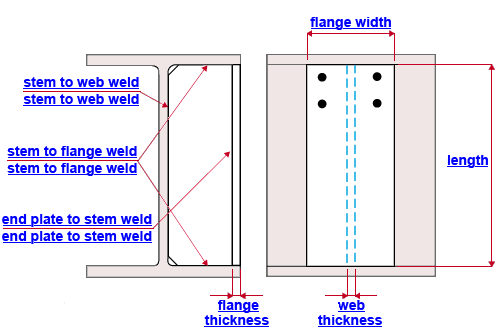"  Welded Tee " connection design locks
Welded Tee " connection design locks
|
|||||
|
" ( a full-depth tee is shown in this example )  |
|
||||
|
|||||
Connection Guide: Click here (clip angle), here (bent plate) or here (end plate).
User Defined Connections: Settings that are locked (
) in a user defined connection file will automatically be locked on a member edit window for which that file is the " Input connection type ." You can, if you so choose, manually lock additional settings on the member edit window, and your changes will be retained, through multiple processes, so long as you do not change to a different connection then switch back to the original user defined connection.
Beam Edit: To change a setting, first set it to locked (
). Related settings that are unlocked (
) may be updated, and the "
Left/Right end limit state " calculations will be updated. Settings that are locked (
) will not be changed by connection design , even if doing so might prevent a connection failure.
Connection design locks :
| Locks not dimensioned or called out on the drawing are marked ( not depicted ). |
![]() Welded Tee
Welded Tee
( for clip angles, bent plates or end plates in beam-to-beam framing situations )
Hole type ( not depicted ): Standard round or Short slot or Oversized or Long slot or User slot #1 or User slot #2 . The hole type selected here, together with the bolt diameter set for the clip angle, end plate or bent plate, set the diameter of holes in the flange plate of the built-up tee.

Tee length ( length ): The depth of the plate that the clip angle, end plate or bend plate bolts to. This is also the depth of the built-up tee's "web" or "stem." You can measure this distance from the edge of the built-up tee's web that welds to the top flange of the supporting beam to the opposite edge of the tee web, which will weld to the bottom flange of the supporting beam if the tee is full-depth (see example ).
Failure message (beam): Locked welded tee length less than minimum required
Failure message (joist): Locked welded tee length less than minimum requiredFailure message (beam): Locked welded tee length greater than maximum allowed
Failure message (joist): Locked welded tee length greater than maximum allowedTee flange width ( flange width ): The width of the plate that the clip angle, end plate or bent plate bolts to. This plate is the built-up tee's flange plate (see example ). Changing the " Tee flange width " results in the automatic adjustment of the " Tee flange refx " so that the tee flange remains centered on the tee web.
Tee flange thickness ( flange thickness ): The thickness of the plate that the clip angle, end plate or bent plate bolts to (see example ). This plate is the built-up tee's flange plate.
Tee flange refx ( not depicted ): A positive or negative (-) distance that slides the tee flange sideways in a direction that is parallel with the " Tee flange width " dimension.
Tee web thickness ( web thickness ): The " Material thickness " of the plate that welds to supporting beam. This plate is the built-up tee's web plate (see example ).
Failure message (beam): Welded tee web strength exceeded
Failure message (joist): Welded tee web strength exceededStem to flange weld: The fillet weld size for shop welding the top and bottom edges of the web plate (stem) of the built-up tee to the top and bottom flanges of the supporting beam (see example ).
Stem to web weld: The fillet weld size for shop welding the edge of built-up tee to the web of the supporting beam (see example ).
Failure message (beam): Welded tee to supporting weld strength exceeded
Failure message (joist): Welded tee to supporting weld strength exceededEnd plate to flange weld ( not depicted ): The fillet weld size for shop welding the built-up tee's flange plate to the flange of the beam.
End plate to stem weld: The fillet weld size for shop welding the built-up tee's web plate (stem) to the built up tee's flange plate (see example ).
Failure message (beam): Welded tee flange-web weld strength exceeded
Failure message (joist): Welded tee flange-web weld strength exceeded







